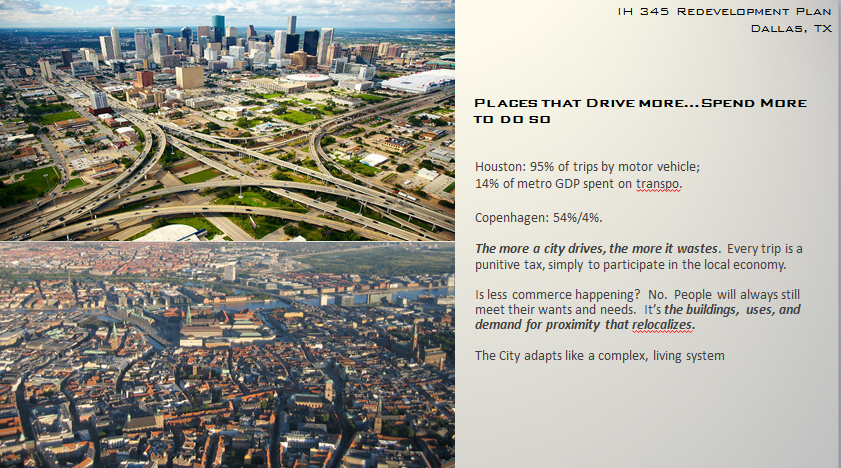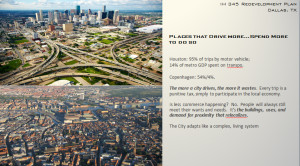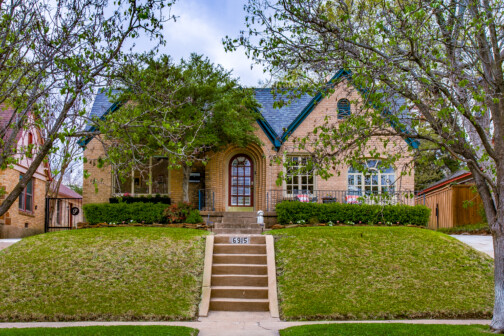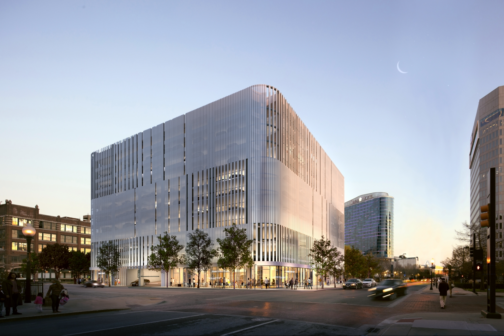Yesterday, on twitter, on this very blog, and in my presentation to the local Sierra Club, I mentioned the difference between the 20th century city and the 21st century city (and by city, I refer to the physical embodiment of local economies). In the 20th century city and economy, the consumption of natural resources was considered both to be economic development in action as well as a symbol of wealth. As we know, this was misguided in ways that I’ll explain and the 21st century city/economy learned from and adapted into a new direction, realizing that there were inherent inefficiencies in what was essentially cradle to grave processes.
I’ve also often written about the idea that the modern city and its form, modern being of its particular time, was formed by and a physical response to the primary interconnective technology of the day. I say interconnective rather than transportation because how we understand the “chemical” bonds of the city as a molecule is changing. In writing about this, I was merely aping Prof Peter Newman who theorized that all cities throughout time are about an hour wide. Thirty minutes to the center of action from all directions, by whatever the prevailing transportation technology of its time.
This has some legs when you start seeing average commute times in every city across the country (they’re remarkably consistent despite widely varying forms, generally between 25-35 minutes) as well as public surveys citing the preferred commute time of about 20 minutes (22 to be precise based on averaging out the feedback). Why isn’t the preferred commute time 2 minutes instead of 22? Apparently because people like to prepare before work and decompress after work. There is a necessary psychological preparation period between lives so to speak.
As I argued in the piece linked above, the car is no longer “high tech.” It is well beyond its peak, technologically and functionally in its service to the city and its people. VMT (vehicle miles traveled) trend lines and the auto-industry rest my case for me. Instead, I argued that the next primary transportation technology is the internet. However, it is so new, in its infancy, that it hasn’t yet had the full impact on cities. The car was invented at the turn of the 20th century, but its full impact wasn’t felt until 50-100 years later. The micro-processor was invented right around the time that cars began to reach maturity in how we planned and designed cities around them. Now, they’ve pretty much matured to the point that we can’t shrink them or squeeze much more efficiency out of them, fifty years hence. There is no magic to the number 50. However, we can assume that the internet will eventually be the guiding force behind planning and development of cities. Perhaps fifty years after its adoption into everyday life. Who knows.
However, in this piece I want to write more metaphorically about the tale of these two cities, the 20th and 21st century cities and their ideal. While the car dominated the 20th century city, there are also some parallels between its internal combustion engine and how we viewed both cities and economies during that period (and unfortunately, there is still far too much remnant flotsam and jetsam floating around today). Likewise, I suspect that the microprocessor, the engine behind our modern handheld and laptop transportation devices serves as a lesson for the direction the new city is heading. And those cities lagging behind would be wise to follow.
With regards to the internal combustion engine and the 20th century city/economy, bigger was often seen as better. A great big hemi F150 (I have no idea if that is a real thing, but it sounds real to me) was a form of braggadocio, an opulent symbol of wealth whether true or not. Not only is it big and takes a lot of space and get outta my way, but it burns quite a bit of fuel and that means horsepower and that I’m rich enough to afford it. This is the 20th american city (and increasingly, it’s becoming the Warholian tomato soup can model for cities in China, India, and the Middle East). Everything had to be bigger and consume more. Because more consumption meant an increase in GDP. Have I ever mentioned how bad of a statistic GDP is (or most statistics)?
An interesting side note is that I also don’t blame large vehicle owners in the states. I see them as a by-product of the competition for space, just like having a small vehicle in European cities is a by-product of the competition for much less, and much more crowded space. It’s also more valuable space, because it is part of an intricately interconnected inner-workings of neighborhoods. Land there is too valuable to be composed of parking, paving, and freeways. Meanwhile, on this side of the pond, the road is the competition. Everybody else is in the way, competing in the futile race to the next red light, as if it might get you ahead. Metaphorical indeed.
But it also points to the new direction. Wherein pedestrian cities, other people aren’t competition but cooperation. Other people keep you safe via eyes on the street. Car-dependently designed transportation networks (and in turn cities) work at optimal condition when nobody else is on the road. This is a problem. As the city is a machine of collisions, bringing skills, labor, ideas, and every other necessary in the stew of human progress, this creates anti-city. In the city of the future, with our handheld inter-connective devices, we are walking and biking more often, because there is both an economic component, being more energy efficient, and a pleasurable component. We’re still making the same socio-economic bonds, but in a way that makes us healthier and happier. Our cities too.
The internet is our new super highway system. Allowing us to maintain socio-economic bonds. It is our new infrastructure. We’ll still need certain heavy, physical infrastructure for global commerce, however I expect that to diminish as well as the world relocalizes and becomes smarter and more efficient. The cheapest thing to send around the globe is ideas. What comes with ideas is skills and the ability to produce that which we need. Meanwhile, the microprocessor is democratizes means of production in the form of 3D printing and who knows what next.
However, in this new, smarter, cleaner, greener city that heavy infrastructure goes behind the scenes. Cities once built mega highways as symbols and (more importantly) the belief in progress. Except it wasn’t. It was merely waste. As we’re slowing finding out. The new infrastructure is still there, but its in data centers, we’re hiding it from view, but it’s still necessary from a functional standpoint. There isn’t a point in flaunting it. That would be an inefficient and inelegant use of land.
The sign of wealth creation now is reduction of waste. Being smarter. Where the internal combustion engine and the cities of the 20th century got bigger due to “efficiencies of scale,” we’ve learned bigger isn’t better, but better is better. Nobody has a mainframe computer anymore. We want elegant, slickly designed gadgets. The processors and the memory got smaller and more efficient. Our cities too will get smaller and more efficient.
The difference is the Model T to the smart phone. The difference is Houston to Copenhagen.
The difference knows the difference between wealth and the simulacra of riches. It pursues efficiency. And in efficiency + desirability it finds walkable, human scaled, safe, clean, and green cities.
Design is no longer about opulent displays of wealth, but more efficient, elegant systems. More efficient, elegant cities. And no Pritzker Prize winners.







